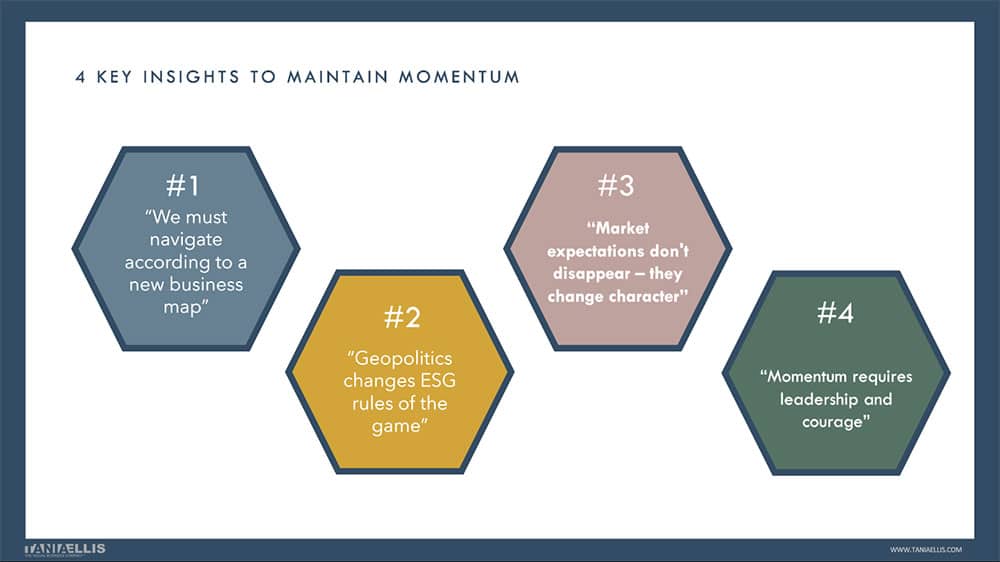By Tania Ellis
How can companies move beyond merely meeting ESG requirements to actively capitalising on them and creating value for both society and the bottom line?
As businesses across the globe face increasingly stringent ESG reporting demands, they are presented not just with a governance challenge but also with an opportunity for value creation.
To build a robust business case that ties compliance to business strategy, you need a deep understanding of both regulation and strategic business development.
More specifically, you must be able to navigate a complex landscape and turn compliance into sustainable business opportunities.
Escaping the ESG Compliance Trap
Many companies often fall into what we call the “compliance trap.” In this mindset, the focus is solely on meeting minimum requirements without seeing the broader potential of ESG work.
This approach tends to limit efforts to minimising risk and ensuring legal compliance.
If you can become the catalyst for shifting your company’s view of ESG from a burden to a strategic opportunity, you’ll be instrumental in exploring how these regulations can strengthen the business.
The key to moving from compliance to business development lies in shifting the focus from merely doing “what’s required” to doing “what’s strategically advantageous.”
This involves a fundamental change in how the company views ESG—not as a cost, but as a valuable investment that future-proofs the business.
Four Steps to Bridge Governance and Business Development
To convince leadership of the value of sustainable initiatives, you must demonstrate how ESG efforts contribute to strategic business goals and translate into financial gains.
Additionally, it’s critical to highlight the risks associated with ignoring ESG—such as losing customers, employees, or access to capital.
Building a sustainable business case requires a systematic approach that considers both the opportunities ESG can create and the challenges that can be turned into strategic initiatives.
Here are four steps to guide you through this process:
Double-Materiality Analysis:
Start by identifying the environmental, social, and governance areas most relevant to your business through a Double Materiality analysis.
This method assesses both the impact your business has on society and the impact these factors have on your business.
By understanding where your company has the most influence, you can identify risks and opportunities and focus on actions that create the most value.
Strategic Alignment:
Ensure a strong and relevant connection between your company’s ESG efforts and its business goals.
For example, developing products or services that not only meet environmental standards but also address increasing customer demands for sustainability can drive business growth.
This requires bridging internal competencies to integrate ESG into core business operations.
Stakeholder Engagement:
The ESG landscape is evolving rapidly, and businesses often can’t predict where customers and markets are headed.
For example, corporate customers may already be transforming their business models without broadcasting these changes externally.
Engaging key stakeholders, including customers, suppliers, and investors, in ESG discussions strengthens relationships and opens up new market opportunities.
Quantifying Value:
One of the biggest challenges in building an ESG business case is quantifying the value created.
Use tools to calculate both the environmental and social value your company generates, as well as the economic value through cost savings, enhanced brand reputation, or increased market share.
Creating ROI for Both Society and the Bottom Line
By transforming ESG from a compliance exercise into a built-in part of the company’s strategy, significant returns (ROI) can be achieved.
ESG efforts can strengthen the company’s brand, attract and retain talent, and differentiate it from competitors.
Businesses that demonstrate a strong sustainability commitment can access better financing options, such as green bonds or loans with favourable terms.
On the societal front, ESG initiatives can address critical challenges like climate change, social inequality, and sustainable consumption.
Companies that actively work on these issues can not only reduce their negative impact but also create positive change, leading to long-term success.
Change Management Skills: The Secret X-Factor
You may already have an ESG mandate within your organisation—but do you have real buy-in from leadership and the rest of the company?
One critical dimension that cannot be overlooked when planning a sustainable ESG strategy is company culture.
To truly embed ESG efforts across the organisation, effective change management is needed to ensure that everyone is working towards the same goals, across departments and functions.
This “X-factor” is essential to bringing the entire organisation along on the sustainability journey.
The business case for ESG can act as a catalyst for business transformation, but change management is the key to transforming the organisation.
If you’re looking to develop these competencies at the intersection of business, sustainability, and change management, consider enrolling in the market’s most practical Mini MBA with certification: Sustainable Business Change Manager.
This programme is designed to equip you with the tools and knowledge needed to drive effective and sustainable change in your organisation and bridge ESG with strategic business development.
Learn more about the Sustainable Business Change Manager programme here.







![[Portrait] A change agent’s experience: From scattered ESG initiatives to strategic direction](https://www.taniaellis.com/wp-content/uploads/2025/10/baeredygtighed-i-praksis-case-website_ny-1080x675.jpg)